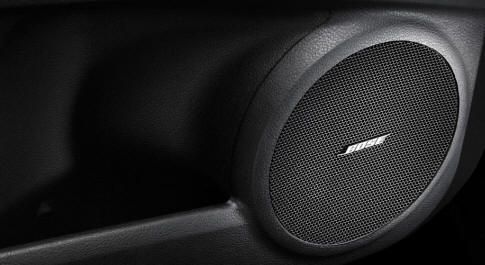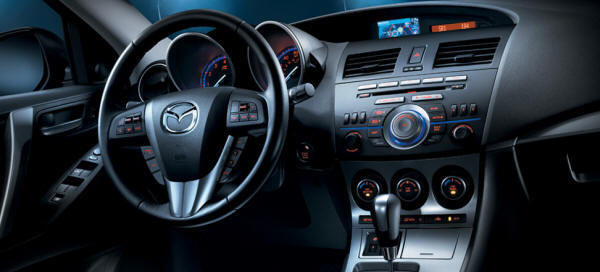|
You are reading the older HTML site
Positive Feedback ISSUE 55
Bose
Centerpoint Car Audio System
I've owned more home audio components than I can remember, but for some reason, never fussed much with the stuff in my car. I've always just checked the "premium sound" option box and lived with whatever stereo came from the factory. Some were good, some were bad, others made no lasting impression at all. With middle age fast approaching, the last thing I want is to sit in the waiting room of a car stereo installation shop alongside the cast from The Fast and The Furious. When my weekly fuel bill busted the $200 barrier recently, I downsized from a Volvo XC90 SUV to a small Mazda3 Grand Touring. Premium sound was a must since the little wagon's interior noise levels aren't luxury class. So, welcome to trademark city. The only premium audio option was a Bose® Centerpoint® Surround Sound system with AudioPilot® 2 noise compensation. Somewhere in Massachusetts, an intellectual property attorney just bought a boat. Certainly, if you're reading this, you're not a typical Bose customer. Neither am I, really—except in this case. Bose customers are happy to pay a premium for unobtrusive simplicity and good sound straight from the box. That's me in a nutshell when it comes to car audio and based on an informal survey of my audiophile friends, it could be you, too. It seems that most of the car audio junkies I know have crappy mass-market systems at home while most audiophiles live with whatever their car comes with. There are exceptions, even some on our staff, but if you've ever been stopped next to a booming 1993 Honda Civic coupe with tinted windows, you realize that most car audio buffs aren't really looking for the same virtues we are. For example, browsing through Crutchfield's online catalog, I came across products like the Rockford Fosgate iBeam, the car audio equivalent to Magic Fingers, which "gives you the kick of a good subwoofer, without having to crank your system up to a high level." Turning your car into a vibrating motel bed has nothing to do with music last I checked. That's why I'm more moved by Bose's promise to "reproduce music as true to the original performance as possible." Marketing-speak or not, it's much less embarrassing.
The Centerpoint system is said to incorporate a 265-watt digital amplifier and 10 speakers. Particularly impressive is the clever way the bass unit was designed to fit snugly within the spare tire, wasting not an inch of valuable space. A center channel speaker is said to provide some semblance of a soundstage, while the digital signal processing is supposed to provide a surround-like experience from stereo program material. In most cases, the Centerpoint technology did in fact do as promised. In particular, it put the lead vocal right near the center stack, something I've never experienced in a car before. The simpler the program material, the better this worked. However, on the whole, it's a fun feature that brings a concert hall quality to most music. Treble was smooth and surprisingly detailed, while bass performance was satisfying and not at all boomy. Don't expect full-range performance but rather, a grown-up sound like you'd get from a good set of small monitors at home. Vocals could sound a bit thin, perhaps because the limitations of a car's typical mounting places don't allow the drivers to integrate as well as they do in home speakers. Imaging was good and it was easy to locate an instrument in the mix. Attack and decay transients were decently well presented, with a slight lack of sharpness compared to the best, but a grippy overall character. The drivers, housed as they are in a mix of plastic and metal, were less likely to reveal their enclosures as part of their sonic signature than others I've experienced. Perhaps Bose was able to EQ out some of the resonances. Dynamics were acceptably good but big shifts lacked the visceral kick I've heard in other systems, all of which were much more expensive options in much more expensive vehicles. FM broadcasts sounded lackluster on the whole: not good, not bad, just so-so. I don't understand why. Looking for answers, I browsed Bose's website and found this: "What you're hearing is a limitation in FM broadcast technology, rather than something broken inside your car. As you've undoubtedly noticed, FM signals become weaker and stronger as you drive. They're also subject to interference, particularly in urban environments. Currently, there's just no way to give an FM broadcast the sound quality of a CD." All of which is true, but I've had plenty of tuners at home and in previous cars that provided excellent performance. The AudioPilot noise compensation employs a microphone inside the cabin to continuously monitor noise levels. Digital signal processing technology analyzes the sound, distinguishing between road noise and music, while reacting only to constant sounds rather than potholes. However, it is designed to react to short bursts of noise as well from such things as rough roads. The effect is subtle—as you'll find out when you turn it off and then on again—but useful. With the volume turned up, there was less of a sense that the stereo was shouting over the road noise.
Though Bose is notorious for trademarked gimmickry, the overall performance of this system is notably straightforward in a good way. The cynical approach toward selling an option like this is to wow drivers during a brief test drive, assaulting them with earth-shaking bass or ultra-crisp treble that quickly becomes fatiguing after the new car smell wears off. Not so here. The perennial audiophile knock against Bose is that one can assemble a better quality system from separate components for a lower price—an argument which sort of misses the point since the typical Bose customer doesn't want separates in the first place. It's hard to say how much the system here actually cost since it came bundled as part of a $2965 upgrade that includes heated leather seats, automatic climate control, sunroof and other goodies. It's available on lower trim levels for $1395 bundled with a moonroof. Volkswagen charges $1000 for a moonroof alone on the 2011 Golf, while Ford gets $795 on the 2012 Focus. Split the difference, subtract the moonroof and you're talking less than $500 for the Bose system including an in-dash, six-disc changer and steering wheel audio controls. For those who never thought they'd see the words "Bose" and "bargain" in the same sentence, here it is. I seriously doubt you could assemble a similar quality system for anywhere near that price. Since you can't have one without the other, it's worth mentioning that the Mazda3 is screwed together exceptionally well, which is a big help since there's nothing worse than turning up the volume only to be greeted by buzzing and rattling door panels. Granted, $25,000 is a lot for a compact car, but the interior materials are within shouting distance of Audi, doors shut with a solid whump, the seats are supportive and most switchgear feels good. Steering, braking and handling approach BMW levels of precision and feedback in everyday driving situations and the suspension is quite composed with just the right amount of damping. It's one of the best performing front wheel drive cars I've driven, let down only by its torquey but not especially rev-happy 2.5 liter 4-cylinder motor which returns only 22 miles per gallon city and 29 on the highway and sounds guttural at lower revs. What we probably need now more than anything else in this country is premium small cars: compact, efficient vehicles with all the stuff you'd expect in a big luxury barge. The audio system in the Mazda3 certainly helps me forget I'm driving something relatively economical. It's funny that the flat-earthers might understand this Bose product best. Here, the system approach not only works best, but also turns out to be the least costly solution for good sound.
|


